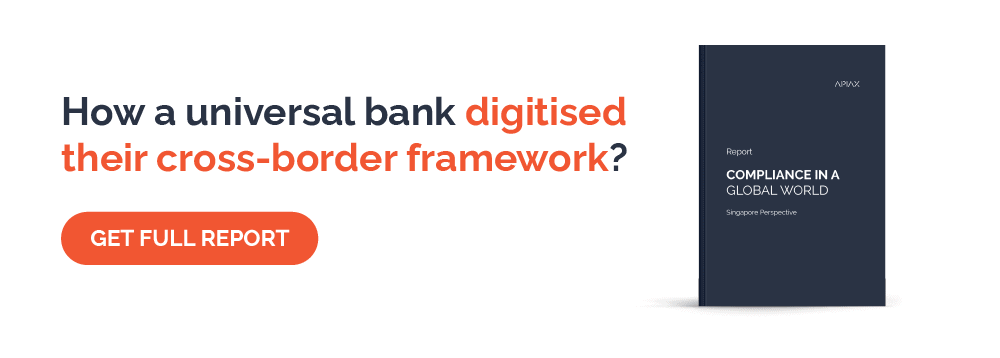Over the last few months, Apiax has successfully digitised cross-border compliance rules for a global universal bank with a strong client base in Singapore. The client was using a traditional, analogue cross-border compliance solution to manage regulatory restrictions across more than 80 countries. They asked Apiax to substantiate the benefits of using digital cross-border compliance rules for them.
In this article, we explain how Apiax helped to implement digital cross-border compliance rules and how financial institutions can benefit from a competitive advantage on a global scale with digital regulatory compliance solutions.
What is cross-border compliance in banking?
Financial institutions seeking to serve a global client base must cope with a growing list of ever-changing country-specific regulations. To understand and manage these regulatory questions involved, financial institutions need to maintain what is commonly called a cross-border framework.
Cross-border exposure is one of the main risks faced by financial institutions today. To further comprehend the impact of country-specific regulations on cross-border banking, Apiax conducted a global survey on the state of cross-border compliance.
The survey shows that the increase in country-specific regulations has clear business-limiting implications for financial institutions. In short, the business potential of serving a larger client base is counteracted by the complexity of the rules that need to be followed when serving these clients.
Traditional vs digital cross-border compliance rules
The tension between serving clients around the world and complying with local regulations is in large part the result of the shortcomings of traditional, manual approaches to cross-border compliance.
Implementing digital cross-border rules promises compliant cross-border banking across as many jurisdictions as desired. The promise is essentially that digital cross-border solutions embed compliance knowledge exactly where it is needed, in business-friendly language and easier to maintain than ever before. The client asked Apiax to back up these promises in a proof of concept.
Digital cross-border compliance rules: a proof of concept
Apiax worked with a global universal bank that has a strong client base in Singapore to demonstrate the benefits of using digital cross-border compliance rules. The client used a traditional cross-border framework to manage country-specific regulations in more than 80 countries.
The foundation of the client’s cross-border framework was text-based policies (cross-border country manuals) that outlined the do’s and don’ts for each country, regular on-the-job training and, among other things, an approval process to enforce travel restrictions.
To improve their cross-border compliance processes, the client asked Apiax to help integrate compliance knowledge right into their business processes and reduce the role of manual input through training and external specifications.
The solution proposed to the client included the tasks of:
- Digitising cross-border manuals;
- Setting up a web-based rule management platform where relevant stakeholders could keep the rules up to date and in line with internal policies and practices;
- Helping to integrate the digital cross-border repository into the existing tool stack.
As part of this proof of concept (PoC), Apiax digitised the client’s existing cross-border country manuals. Our business analysts and regulatory engineers first analysed the business use case in question, to identify the regulatory challenges to be solved. The regulatory engineers then worked backwards to unify and structure global regulation applicable to that business use case.
Apiax also provided the client with a web-based rule management platform where relevant stakeholders could keep rules up to date and in line with internal policies and practices, and with integration options to link these rules to the existing technology stack.
The client was now able to provide hundreds of account managers with yes-or-no answers on their most frequent regulatory questions right in their existing tools. Implementing this approach met the client’s requirements. It strengthened the bank’s compliance framework and simplified the lives of customer-facing staff.

The potential of digital cross-border compliance rules
This PoC with our client in Singapore should underpin the promise of digital cross-border compliance. Could it bring productivity gains, a reduction in cross-border compliance risks and easier adaptation of services and products for new markets?
Most importantly, can digital cross-border compliance rules resolve the tension between the business interest of serving a global customer base and the need to comply with local regulations? We are pleased to report that implementing this PoC achieved all of these goals.
These are good news for the financial industry. It shows that it is possible to remain compliant without sacrificing growth, innovation or customer focus. Smart compliance solutions empower firms to overcome the tension between a global customer base, increasing regulation and increased competition.
Based on the assumption that not all organisations will adapt at the same speed, digitised compliance offers a real competitive advantage for those who truly want to leverage their businesses from it.

